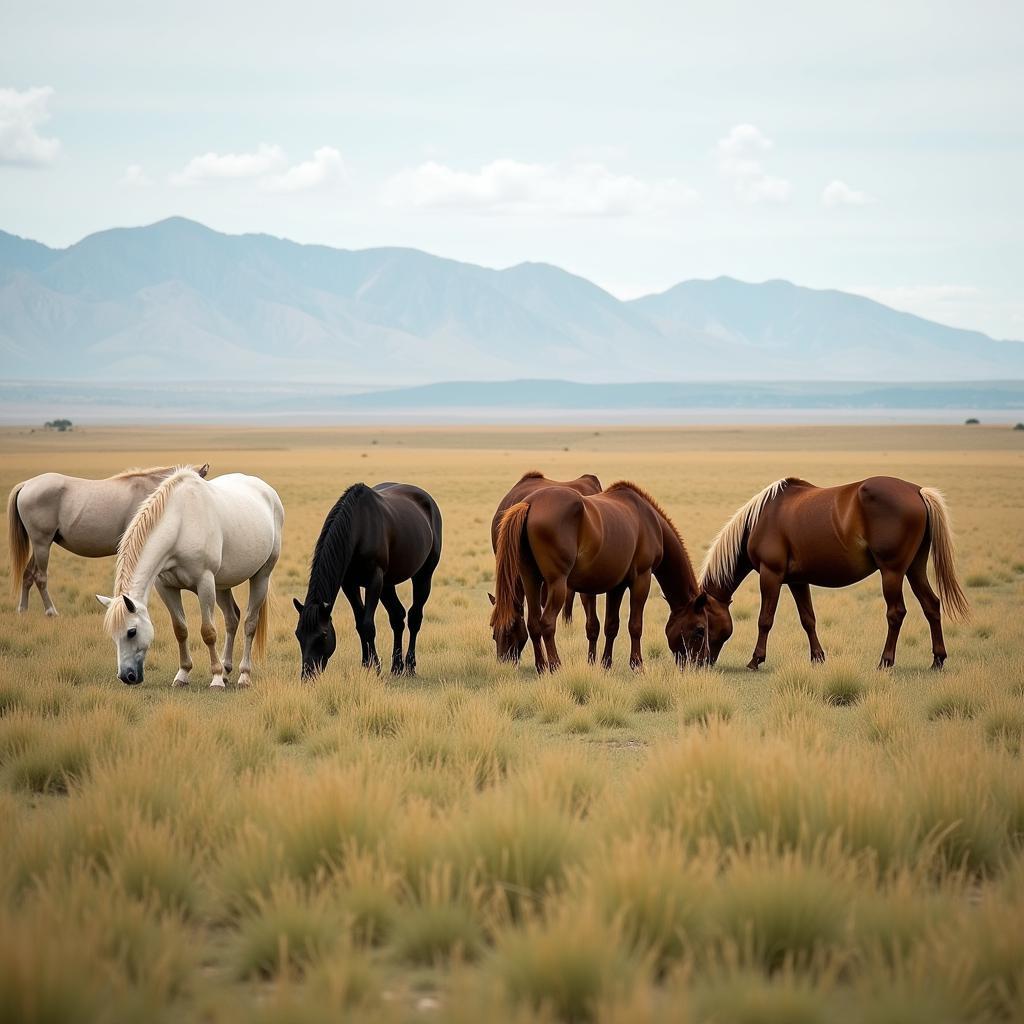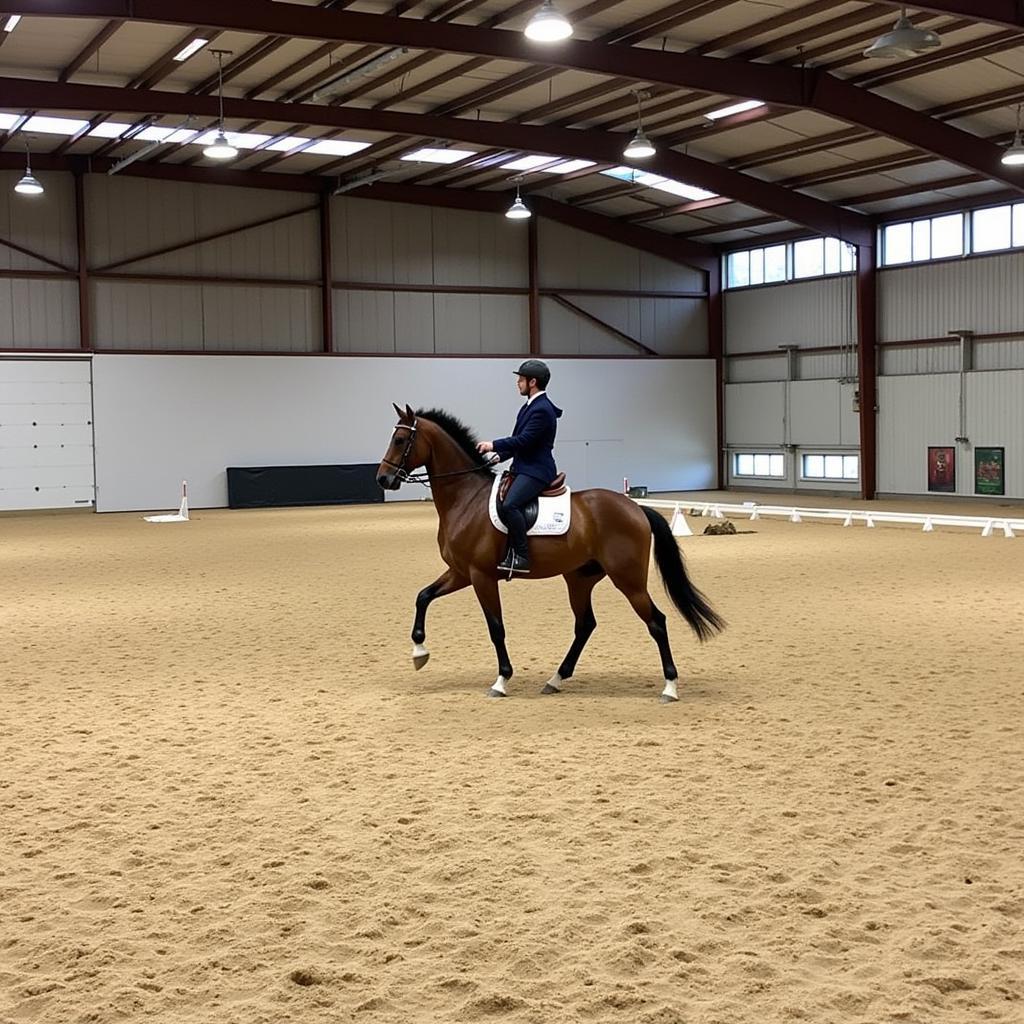The term “Horse Plain” might seem a bit puzzling at first. Is it a specific breed? A unique riding style? Actually, “horse plain” itself isn’t a commonly used phrase within the equestrian world. However, it offers a fascinating lens through which to explore the diverse landscapes horses thrive in and the ways we, as horse enthusiasts, can better understand and care for these magnificent animals.
Horses and Their Habitats: From Open Ranges to Rolling Hills
 Horses Grazing on an Open Plain
Horses Grazing on an Open Plain
When we dissect the phrase “horse plain,” we can interpret it as a reference to the natural environments where horses have historically flourished. Think wide-open plains, sprawling grasslands, and rolling hills – landscapes that provide ample grazing opportunities and freedom of movement. These habitats have shaped the horse’s physiology and instincts over millennia.
For instance, the horse’s digestive system, designed for continuous grazing, is perfectly suited to the abundant forage found in these open areas. Similarly, their powerful legs and hooves, ideal for covering long distances, reflect the expansive nature of their natural homes.
Beyond the “Plain”: Exploring Diverse Equestrian Landscapes
 Horse and Rider Training in an Indoor Arena
Horse and Rider Training in an Indoor Arena
While the image of horses roaming free on vast plains holds a certain romantic appeal, it’s essential to recognize that horses are incredibly adaptable animals. From the rugged mountains to coastal shores, horses have proven their resilience across a variety of terrains.
Understanding this adaptability is key to providing optimal care for our equine companions. The type of terrain a horse lives on can influence their hoof care needs, exercise routines, and even their nutritional requirements. For example, horses living in rocky, mountainous regions might require more frequent farrier visits and specialized hoof protection compared to those on softer ground.
Creating “Plains” for Our Domesticated Horses: Pasture Management and Beyond
 Horse Owner Inspecting Fence Line in a Pasture
Horse Owner Inspecting Fence Line in a Pasture
For those of us who care for domesticated horses, it’s our responsibility to create environments that mimic the best aspects of their natural habitats. This begins with providing ample space for movement and grazing, even if it’s on a smaller scale than the vast plains of wild horse herds.
Pasture management is crucial. Rotating grazing areas, ensuring a consistent water supply, and maintaining healthy grass growth are all essential for creating a thriving “plain” for your horse. Additionally, providing enrichment activities that stimulate their minds and bodies, such as interactive toys, obstacle courses, and regular training sessions, will help keep your horse happy and engaged.
Choosing the Right “Plain” for Your Horse: Factors to Consider
Selecting the ideal environment for your horse involves considering several factors:
- Breed: Some breeds, like Thoroughbreds and Arabians, have evolved to thrive in open, flat terrains, while others, like Icelandic Horses and Fjords, are more accustomed to hillier, rockier landscapes.
- Discipline: The type of riding discipline you practice will also influence the type of terrain that best suits your horse. A dressage horse, for instance, benefits from a level, well-maintained arena surface, while a trail horse will appreciate access to varied and challenging terrain.
- Individual Horse’s Needs: Each horse is unique. Consider your horse’s age, health, temperament, and previous experience when choosing their environment and management practices.
Conclusion
While the phrase “horse plain” might not have a singular, definitive meaning in the equestrian lexicon, it serves as a powerful reminder of the deep connection between horses and their environment. Whether your horse grazes on sprawling pastures or enjoys regular rides through wooded trails, understanding their innate needs and adapting their care accordingly is paramount to their well-being. By striving to create environments that mimic the best aspects of their natural habitats, we can ensure that our equine partners live long, healthy, and fulfilling lives.
FAQs
1. What is the best type of terrain for a horse?
There’s no one-size-fits-all answer! The ideal terrain depends on factors like breed, intended use, and individual needs.
2. Do horses need a lot of space?
Horses thrive with ample space to roam and graze. Even if you don’t have acres of land, providing access to turnout and exercise is crucial.
3. How can I tell if my horse’s environment is suitable?
Observe your horse’s behavior. A content horse will be relaxed, have a healthy appetite, and show an interest in their surroundings.
Have other questions? Explore more insightful articles on our website, like our guides on horse supplements for energy and American Horse Connection.
For personalized advice and support, contact our team at:
Phone: 0772127271
Email: [email protected]
Address: QGM2+WX2, Vị Trung, Vị Thuỷ, Hậu Giang, Việt Nam
We’re here to help you provide the best possible care for your equine companions.